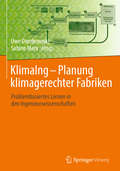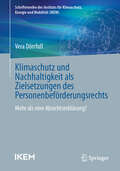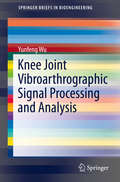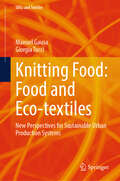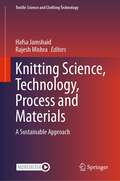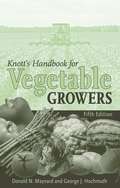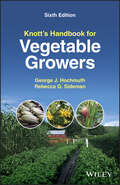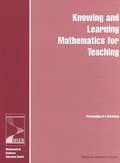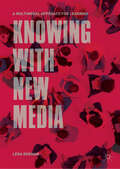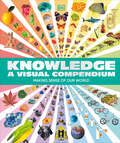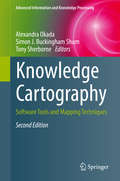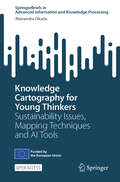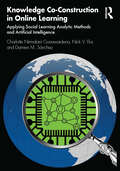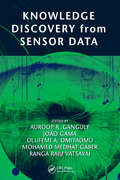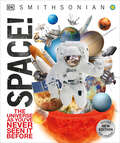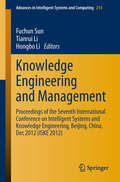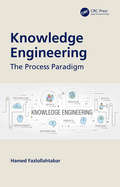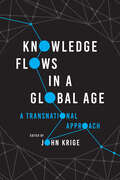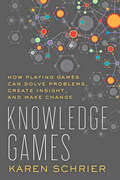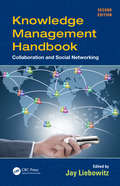- Table View
- List View
KlimaIng - Planung klimagerechter Fabriken: Problembasiertes Lernen In Den Ingenieurwissenschaften
by Uwe Dombrowski Sabine MarxDie mit dem Klimawandel verbundenen Risiken haben auch Konsequenzen für produzierende Unternehmen und ihre Produktionsstätten. Daher widmet sich das Buch der klimagerechten Planung von Fabriken und verknüpft dieses ingenieurwissenschaftliche Fachgebiet mit Grundlagenwissen zur Planung und Durchführung problembasierter Lehrveranstaltungen an Hochschulen. Im ersten Teil beschreiben die Autoren die Grundlagen des Klimawandels und der Fabrikplanung. Sie stellen zum einen die Vorgehensweisen zur Identifizierung von Klimarisiken und zum anderen Planungsansätze zu deren Reduzierung vor. Der zweite Teil verknüpft diese ingenieurwissenschaftlichen Aufgabenstellungen mit dem Konzept problembasierten Lernens. Dabei wird problembasiertes Lernen als Lehrmethode zum Erwerb und zur Anwendung praxisrelevanten Fachwissens verstanden, die stets die Lernenden in den Mittelpunkt stellt. Neben theoretischen Grundlagen und aktuellen Forschungsergebnissen zur Wirksamkeit problembasierten Lernens erhalten Leser hier auch Hinweise für die Implementation in der Praxis. Am Beispiel einer problembasierten Lehrveranstaltung, die im Rahmen eines Forschungsprojektes entwickelt wurde, wird eine didaktische Konzeption zur Planung und Durchführung problembasierter Lernumgebungen vorgestellt. Diese Modell-Lehrveranstaltung ist so aufbereitet, dass das Konzept ohne viel Aufwand auf andere Themengebiete der Ingenieurwissenschaften übertragen werden kann. Der dritte Teil des Buchs bietet eine Fallsammlung zu unterschiedlichen Lernzielen. Diese dienen Nutzern als Vorlage, um selbst geeignete Fälle für problembasierte Lernumgebungen zu konstruieren. Das Buch richtet sich an Lehrkräfte in ingenieurwissenschaftlichen Studiengängen, insbesondere solche mit dem Schwerpunkt Klimawandel und Fabrikplanung.
Klimaschutz und Energiewende in Deutschland: Herausforderungen – Lösungsbeiträge – Zukunftsperspektiven
by Udo SahlingWie kann man Klimaschutz vor Ort erfolgreich umsetzen?Nach mehr als 20 Jahren Klimaschutzpolitik ziehen Autor*innen in diesem Handbuch Bilanz, wie Klimaschutz auch unter ungünstigen Rahmenbedingungen umgesetzt werden kann. Die vielseitige Zusammenstellung der Beiträge soll Leser*innen helfen, die ökonomischen und technologischen und vor allem gesellschaftspolitischen Veränderungen dieser Zeit zu erkennen und daraus Lehren für die Zukunft von Klimaschutz und Energiewende zu ziehen.Klimaschutz erfährt zurzeit durch die „Fridays for Future“-Bewegung große Popularität. Die nachfolgende Generation will wissen, was anders gemacht werden muss, damit es künftig besser laufen kann. Gerade wird uns zudem brutal vor Augen geführt, was die hohe Importabhängigkeit von fossilen Energieträgern bedeutet und dass es nur einen Erneuerbaren Weg gibt. Das Werk greift diese Aspekte auf und soll Mut machen, sich an einer emissionsfreien Zukunftsgestaltung zu beteiligen.
Klimaschutz und Nachhaltigkeit als Zielsetzungen des Personenbeförderungsrechts: Mehr als eine Absichtserklärung? (Schriftenreihe des Instituts für Klimaschutz, Energie und Mobilität)
by Vera DörrfußDurch das Gesetz zur Modernisierung des Personenbeförderungsrechts vom 16.04.2021 wurde § 1a PBefG in das PBefG neu eingefügt. Damit hat das PBefG neben der gefahrenabwehrrechtlichen Komponente mit Klimaschutz und Nachhaltigkeit eine Weitere hinzugewonnen. Die Norm ist trotz ihres mittlerweile mehr als dreijährigen Bestehens wissenschaftlich noch weitestgehend unerforscht und auch in der Praxis nicht, beziehungsweise kaum bekannt. Dabei stellen sich in ihrem Zusammenhang viele Fragen. So bleibt bei der bloßen Lektüre unklar, welchen Inhalt der abstrakt gehaltene § 1a PBefG haben soll. Es ergibt sich weder, was unter den Klimaschutz- und Nachhaltigkeitszielen zu verstehen ist, noch welche Reichweite ihrer Berücksichtigung zukommen soll. Unklar bleibt auch, ob der Gesetzgeber eine wirkliche Veränderung bei der Anwendung des PBefG und damit positive Auswirkungen auf Klima und Nachhaltigkeit herbeiführen möchte oder es sich vielmehr um sog. „Greenwashing“ handelt. Diese und noch viele weitere Fragen, nimmt die Arbeit zum Anlass, um die neue Maßgabe des PBefG, bei Anwendung des Gesetzes die Ziele des Klimaschutzes und der Nachhaltigkeit zu berücksichtigen, genauer zu untersuchen.
Knee Joint Vibroarthrographic Signal Processing and Analysis
by Yunfeng WuThis book presents the cutting-edge technologies of knee joint vibroarthrographic signal analysis for the screening and detection of knee joint injuries. It describes a number of effective computer-aided methods for analysis of the nonlinear and nonstationary biomedical signals generated by complex physiological mechanics. This book also introduces several popular machine learning and pattern recognition algorithms for biomedical signal classifications. The book is well-suited for all researchers looking to better understand knee joint biomechanics and the advanced technology for vibration arthrometry. Dr. Yunfeng Wu is an Associate Professor at the School of Information Science and Technology, Xiamen University, Xiamen, Fujian, China.
Knitting Food: New Perspectives for Sustainable Urban Production Systems (SDGs and Textiles)
by Manuel Gausa Giorgia TucciThis book focuses on the emerging field of food waste-based eco-textiles. Eco-textiles, eco-leathers and bio-skins are now an important category of biomaterials with immediate applications in sustainable industrial production and the circular economy. In this sense, the book brings together new collaborative and interdisciplinary projects and artistic crossovers specialised in eco-textile research, (re)design and functional use of organic and food waste, in a vision that starts from the product dimension and reaches the urban scale.
Knitting Science, Technology, Process and Materials: A Sustainable Approach (Textile Science and Clothing Technology)
by Hafsa Jamshaid Rajesh MishraThis volume explains knitting technology in an easily-comprehensible and user-friendly manner. The manufacturing of a cost-effective quality product requires careful planning and thorough knowledge of the product as well as production technology. To achieve the desired functional properties in fabric, the relationship between the raw materials, process and finished product is very important. Knitting has been and remains an important textile technique due to the properties of knitted fabric such as elasticity, stretchability, and comfort. Despite the prominence of knitwear, there has been limited data regarding mechanics of weft knitted fabric and effect of structures on physical, mechanical and comfort properties. This book is an attempt to fill that gap. The book provides knowledge about fabric manufacturing techniques, weft knitting structure, and methods of evaluating knitted fabrics and their applications in technical textiles. It also discusses different types of yarn and their manufacturing processes. Testing and quality control in industrial practice as well as management of a fabric dyeing house are also covered.
Knives Cooks Love: Selection, Care, Techniques, Recipes
by Ben Fink Sarah Jay Sur La Table StaffIn 'Knives Cooks Love', trusted cookware authority Sur La Table teams up with writer Sarah Jay to guide chefs of all levels so their knives will last a lifetime. The nuances between knife blades and handles are discussed, as well as cutting surfaces and an array of sharpeners and honers. Numerous cutting techniques are also showcased with step-by-step instructions and photographs. These skills are then put to the test with more than 20 knife-essential, tantalising recipes like Mango-Cucumber Salsa, Mediterranean-Style Mussels with Fennel and Tomatoes, Arroz con Pollo with Chorizo and Capers, and Bread and Butter Pudding with Rum and Crystallised Ginger.
Knott's Handbook for Vegetable Growers
by Donald N. Maynard George J. HochmuthThe leading one-stop reference for commercial vegetable growers for more than 50 yearsRooted in tradition, branching out to the future. For more than half a century, Knott's Handbook for Vegetable Growers has provided generations of commercial growers with the most timely, accessible, and useful information available on the subject. The Fifth Edition of this highly regarded horticultural mainstay provides readers with the reliable growing and marketing information they've come to expect, while including new and updated material throughout to maintain its relevance in our ever-changing world.Filled with valuable information, largely in the form of tables and charts--from hard statistics on vegetable production and consumption to essential information for today's international markets, such as vegetable botanical names and vegetable names in nine languages--Knott's Handbook is part Farmer's Almanac, part encyclopedia, and part dictionary. It also provides detailed, practical specifics on planting rates, schedules, and spacing; soils and fertilizers; methods for managing crop pests; greenhouse vegetable and crop production; insect pest identification; harvesting and storage; and vegetable marketing.Now available in a new flexible cover designed for ease of use on the desk or in the field, this valuable workhorse features new information on:* World vegetable production* Best management practices* Organic crop production* Food safety* Pesticide safety* Postharvest problems* Minimally processed vegetables* Plus, hundreds of Web site links related to vegetable information
Knott's Handbook for Vegetable Growers
by George J. Hochmuth Rebecca G. SidemanKnott’s Handbook for Vegetable Growers Authoritative and comprehensive go-to reference work for commercial vegetable growers around the world For more than 65 years, Knott’s Handbook for Vegetable Growers has provided generations of commercial growers with the most timely, accessible, and useful information available on the subject, containing key guidance on transplant production, planting rates and spacing, irrigation, fertilization, methods for controlling diseases, and insect pest identification, plus important information on topics such as composting, post-harvest storage and processing, genetically-engineered crops, organic growing, federal regulations and best management practices, environmentally friendly pest management, and food safety. To allow for convenient and efficient access to the enormous amount of data contained within, most of the information is presented in the form of tables and charts. The work goes above and beyond to provide everything a reader needs to know on the subject, even including a multilanguage vegetable dictionary. Now in its 6th edition, the work has been significantly expanded and modernized to cover key modern advancements in the industry, such as: Computer-based crop monitoring technologies, robotic disease control and harvesting systems, and new protected-ag production systems (including vertical systems and indoor production) New production systems pertaining to protected organic agriculture, soil moisture sensing, environmental monitoring, soil health, and soil conservation New technologies, including satellite-based decision-making, robotics, and UAVs for increasing production efficiency The various advances that have been made in food safety regulations, plus coverage of new invasive pests Part Farmer’s Almanac, part encyclopedia, and part dictionary, Knott’s Handbook for Vegetable Growers serves as an invaluable asset for growers, students, and other industry professionals seeking an all-in-one reference for all of the questions they have on both holistic and specific facets of the commercial vegetable industry.
Knowing and Learning Mathematics for Teaching
by Mathematics Teacher Preparation Content Workshop Program Steering CommitteeThere are many questions about the mathematical preparation teachers need. Recent recommendations from a variety of sources state that reforming teacher preparation in postsecondary institutions is central in providing quality mathematics education to all students. The Mathematics Teacher Preparation Content Workshop examined this problem by considering two central questions: What is the mathematical knowledge teachers need to know in order to teach well? How can teachers develop the mathematical knowledge they need to teach well? The Workshop activities focused on using actual acts of teaching such as examining student work, designing tasks, or posing questions, as a medium for teacher learning. The Workshop proceedings, Knowing and Learning Mathematics for Teaching, is a collection of the papers presented, the activities, and plenary sessions that took place.
Knowing with New Media: A Multimodal Approach for Learning
by Lena RedmanThis cutting edge book considers how advances in technologies and new media have transformed our perception of education, and focuses on the impact of the privatisation of digital tools as a mean of knowledge production. Arguing that education needs to adapt to the modern learner, the book’s unique approach is based on a disassociation with the deeply ingrained attitude with which people have traditionally viewed education – learning the existing symbolic systems of certain disciplines and then expressing themselves strictly within the operational modes of these systems. The ways of knowledge production – exploring, recording, representing, making meaning of and sharing human experiences – have been fundamentally transformed through the infusion of digital technologies into all aspects of human activity, allowing learners to engage with their immediate natural, social and cultural environments by capitalising on their individual abilities and interests. This book proposes a new approach to teaching and learning termed ‘cinematic bricolage’, which involves generating knowledge from heterogeneous resources in a ‘do-it-yourself’ manner while making meaning through multimodal representations. It shows how cinematic bricolage reconnects ways of knowing with ways of being, empowering the individual with a sense of personal identity and responsibility, helping to shape more aware social citizens.
Knowledge A Visual Compendium: Making Sense of our World
by DKEver wondered how many moons there are in our solar system, or the number of Olympic sports, or who the 46 US presidents were? If so, this is the book for you!Leaf through the pages of this beautiful book and you’ll find an intriguing array of objects, animals, lists, and artifacts from nature, science, technology, the arts, and history, which illustrate how we order, understand, and make sense of the world. Discover the 40 orders of birds, the 13 levels of the Beaufort Wind Scale, the 88 constellations, the 36 Morse Code symbols, the 206 bones in the human body, and much more!With its combination of attractive, timeless images and expert, engaging text, The Knowledge Compendium Book is perfect for children (and adults!) who are curious about the world and the lists, systems, and categories that help us understand it.
Knowledge Building and Regulation in Computer-Supported Collaborative Learning
by Lanqin ZhengThis book proposes and validates an information flow approach to analyzing knowledge co-construction and predicting group performance in the context of collaborative learning. In addition, it highlights the importance of socially shared regulation in collaborative learning, and illustrates in detail how it can be analyzed and promoted. The book investigates several innovative examples, including: Methodological approaches to studying and analyzing knowledge building and regulation in collaborative learning; Social software tools for capturing the dynamics of knowledge building and regulation in collaborative learning; Collective regulatory mechanisms to scaffold socially shared regulation in real-life collaborative learning; and Scripts and interventions to facilitate effective and productive collaborative learning on the basis of several case studies. The original methodological contributions to the analysis of knowledge building and scaffolding socially shared regulation make this an essential read for anyone interested in collaborative learning. This book will also be of interest to a wide audience of researchers, teachers, and students in the field of collaborative learning, as well as the rapidly growing community of people investigating how collaborative learning can be effectively used in education.
Knowledge Cartography
by Simon J. Buckingham Shum Alexandra Okada Tony SherborneKnowledge maps are ideal tools for capturing, organizing and extracting meaning from many different sources. They provide powerful graphic tools for classifying, representing and communicating information. This book discusses significant new research and explains its underlying principles in terms of Knowledge Cartography. With contributions from leading researchers and practitioners, it offers a rich variety of conceptual frameworks, mapping techniques and case studies.
Knowledge Cartography for Young Thinkers: Sustainability Issues, Mapping Techniques and AI Tools (Advanced Information and Knowledge Processing)
by Alexandra OkadaDiscover the transformative power of knowledge mapping with this revolutionary book. You will have access to a rich collection of mapping techniques, technologies, and real-life applications designed for learners of all ages and across disciplines. This book aims to help learners create knowledge with the support of artificial intelligence mapping apps and engage them deeply with sustainable development supported by green digital skills. Experience the dynamic world of mind maps, concept maps, dialogue maps, and more, brought to life by educators, researchers, experts, and young students. This is not just a book; it is a movement toward diverse, interactive learning methods to shape a sustainable future. Perfect for teachers, trainers, nonformal educators, and education professionals, the book embraces the innovative CARE-KNOW-DO framework to transform how young people tackle pressing issues. It combines exploration, understanding, and actionable steps for sustainability. This book offers invaluable resources to help researchers explore trends, connect relevant information, and produce significant narratives supported by AI. It guides the use of knowledge maps in decision-making, sense-making, and inspiring future generations. The book also explores the methodology behind its creation, including case studies, teaching strategies, and learning outcomes, all of which are grounded in extensive literature and ethical standards. Embrace a new era of learning with this open-access book on knowledge mapping. It is set to transform the way we think, research, teach, and learn. It is an open access book.
Knowledge Co-Construction in Online Learning: Applying Social Learning Analytic Methods and Artificial Intelligence
by Charlotte Nirmalani Gunawardena Nick V. Flor Damien M. SánchezKnowledge Co-Construction in Online Learning is a comprehensive, foundational resource that explores the study of social construction of knowledge through platforms, social dynamics, and other aspects of today’s technology-enhanced education. The interactive spaces, from formal computer-supported collaborative learning settings to informal social media-integrative environments, that comprise asynchronous online learning offer a rich source of data for analyzing teaching and learning. How, then, can researchers and designers in educational technology, instructional design, the learning sciences, and beyond most effectively analyze the content and data generated by these complex co-creations of knowledge?Grounded in sociocultural and social constructivist theories of learning and driven by the globally renowned Interaction Analysis Model, this book applies statistical and computational methods to study the group interactions and social networks that yield newly constructed knowledge during virtual learning experiences. Its unique Social Learning Analytic Methods enhance the analysis of social dynamics that support knowledge construction so often missing from mainstream learning analytics. Holistic and cyclical in its approach to online learning experiences, this essential volume written for novice and experienced researchers transcends the field’s research paradigm conflicts, blends qualitative and quantitative approaches with new digital media tools, and exemplifies how research questions and designs can incorporate and automate evolving forms of inquiry.
Knowledge Discovery from Sensor Data
by Mohamed Medhat Gaber Olufemi A. Omitaomu Ranga Raju Vatsavai Auroop R. Ganguly JoÎo GamaAs sensors become ubiquitous, a set of broad requirements is beginning to emerge across high-priority applications including disaster preparedness and management, adaptability to climate change, national or homeland security, and the management of critical infrastructures. This book presents innovative solutions in offline data mining and real-time
Knowledge Encyclopedia Space!: The Universe as You've Never Seen it Before (DK Knowledge Encyclopedias)
by DKA spacetastic new edition beaming with incredible pictures and the latest facts about the universe.From the origin of the universe to the future of space rockets, this book about space for kids has it all.Did you know that the moon was once a piece of the Earth, and that a day on Venus is longer than one year? First published in 2015, Knowledge Encyclopedia: Space! has been completely revised and updated for 2020, with new images and information on all things space-related to send you rocketing to the furthest reaches of the cosmos. Newly updated with the latest scientific discoveries and innovation in space engineering, this new title will answer all your questions about what lies beyond the night sky. Discover how stars and galaxies are formed, take a trip through the Milky Way, and explore the innards of the International Space Station in this incredible book that uses the latest computer-generated 3-D imagery, eye-catching photographs, gripping information, and explanatory diagrams to bring the wonders of the cosmos to life.Knowledge Encyclopedia: Space! is the big bang of space books, and it's just gotten bigger!
Knowledge Engineering and Management: Proceedings of the Seventh International Conference on Intelligent Systems and Knowledge Engineering, Beijing, China, Dec 2012 (ISKE #2012)
by Tianrui Li Hongbo Li Fuchun SunThese proceedings present technical papers selected from the 2012 International Conference on Intelligent Systems and Knowledge Engineering (ISKE 2012), held on December 15-17 in Beijing. The aim of this conference is to bring together experts from different fields of expertise to discuss the state-of-the-art in Intelligent Systems and Knowledge Engineering, and to present new findings and perspectives on future developments. The proceedings introduce current scientific and technical advances in the fields of artificial intelligence, machine learning, pattern recognition, data mining, knowledge engineering, information retrieval, information theory, knowledge-based systems, knowledge representation and reasoning, multi-agent systems, and natural-language processing, etc. Furthermore they include papers on new intelligent computing paradigms, which combine new computing methodologies, e.g., cloud computing, service computing and pervasive computing with traditional intelligent methods. By presenting new methodologies and practices, the proceedings will benefit both researchers and practitioners who want to utilize intelligent methods in their specific fields. Dr. Fuchun Sun is a professor at the Department of Computer Science & Technology, Tsinghua University, China. Dr. Tianrui Li is a professor at the School of Information Science & Technology, Southwest Jiaotong University, Chengdu, China. Dr. Hongbo Li also works at the Department of Computer Science & Technology, Tsinghua University, China.
Knowledge Engineering: The Process Paradigm
by Hamed FazlollahtabarKnowledge management is far-reaching. It can dramatically reduce costs such as costs of office work repetition, human resource retirement, information reuse, etc. Rather than "reinventing the wheel" and having it be a costly and inefficient activity, systematic reuse of knowledge can show substantial cost benefits immediately. This book shows how to develop process-oriented methodologies, covers both interorganizational and enterprises models, discusses how knowledge management can dramatically reduce costs and increase speed of response, presents a wide range of quantitative methods applied to various knowledge engineering problems, and offers several graphical presentations of models and processes. Academicians and practitioners in the area of knowledge management and engineering, especially managers in industries will fine this book useful. The material might also be useful in knowledge management graduate studies.
Knowledge Flows in a Global Age: A Transnational Approach
by John KrigeA transnational approach to understanding and analyzing knowledge circulation. The contributors to this collection focus on what happens to knowledge and know-how at national borders. Rather than treating it as flowing like currents across them, or diffusing out from center to periphery, they stress the human intervention that shapes how knowledge is processed, mobilized, and repurposed in transnational transactions to serve diverse interests, constraints, and environments. The chapters consider both what knowledge travels and how it travels across borders of varying permeability that impede or facilitate its movement. They look closely at a variety of platforms and objects of knowledge, from tangible commodities—like hybrid wheat seeds, penicillin, Robusta coffee, naval weaponry, seed banks, satellites and high-performance computers—to the more conceptual apparatuses of plant phenotype data and statistics. Moreover, this volume decenters the Global North, tracking how knowledge moves along multiple paths across the borders of Mexico, India, Portugal, Guinea-Bissau, the Soviet Union, China, Angola, Palestine and the West Bank, as well as the United States and the United Kingdom. An important new work of transnational history, this collection recasts the way we understand and analyze knowledge circulation.
Knowledge Flows in a Global Age: A Transnational Approach
by John KrigeA transnational approach to understanding and analyzing knowledge circulation. The contributors to this collection focus on what happens to knowledge and know-how at national borders. Rather than treating it as flowing like currents across them, or diffusing out from center to periphery, they stress the human intervention that shapes how knowledge is processed, mobilized, and repurposed in transnational transactions to serve diverse interests, constraints, and environments. The chapters consider both what knowledge travels and how it travels across borders of varying permeability that impede or facilitate its movement. They look closely at a variety of platforms and objects of knowledge, from tangible commodities—like hybrid wheat seeds, penicillin, Robusta coffee, naval weaponry, seed banks, satellites and high-performance computers—to the more conceptual apparatuses of plant phenotype data and statistics. Moreover, this volume decenters the Global North, tracking how knowledge moves along multiple paths across the borders of Mexico, India, Portugal, Guinea-Bissau, the Soviet Union, China, Angola, Palestine and the West Bank, as well as the United States and the United Kingdom. An important new work of transnational history, this collection recasts the way we understand and analyze knowledge circulation.
Knowledge Flows in a Global Age: A Transnational Approach
by John KrigeA transnational approach to understanding and analyzing knowledge circulation. The contributors to this collection focus on what happens to knowledge and know-how at national borders. Rather than treating it as flowing like currents across them, or diffusing out from center to periphery, they stress the human intervention that shapes how knowledge is processed, mobilized, and repurposed in transnational transactions to serve diverse interests, constraints, and environments. The chapters consider both what knowledge travels and how it travels across borders of varying permeability that impede or facilitate its movement. They look closely at a variety of platforms and objects of knowledge, from tangible commodities—like hybrid wheat seeds, penicillin, Robusta coffee, naval weaponry, seed banks, satellites and high-performance computers—to the more conceptual apparatuses of plant phenotype data and statistics. Moreover, this volume decenters the Global North, tracking how knowledge moves along multiple paths across the borders of Mexico, India, Portugal, Guinea-Bissau, the Soviet Union, China, Angola, Palestine and the West Bank, as well as the United States and the United Kingdom. An important new work of transnational history, this collection recasts the way we understand and analyze knowledge circulation.
Knowledge Games: How Playing Games Can Solve Problems, Create Insight, and Make Change (Tech.edu: A Hopkins Series on Education and Technology)
by Karen SchrierAre games the knowledge-producers of the future?Imagine if new knowledge and insights came not just from research centers, think tanks, and universities but also from games, of all things. Video games have been viewed as causing social problems, but what if they actually helped solve them? This question drives Karen Schrier’s Knowledge Games, which seeks to uncover the potentials and pitfalls of using games to make discoveries, solve real-world problems, and better understand our world. For example, so-called knowledge games—such as Foldit, a protein-folding puzzle game, SchoolLife, which crowdsources bullying interventions, and Reverse the Odds, in which mobile game players analyze breast cancer data—are already being used by researchers to gain scientific, psychological, and humanistic insights.Schrier argues that knowledge games are potentially powerful because of their ability to motivate a crowd of problem solvers within a dynamic system while also tapping into the innovative data processing and computational abilities of games. In the near future, Schrier asserts, knowledge games may be created to understand and predict voting behavior, climate concerns, historical perspectives, online harassment, susceptibility to depression, or optimal advertising strategies, among other things.In addition to investigating the intersection of games, problem solving, and crowdsourcing, Schrier examines what happens when knowledge emerges from games and game players rather than scientists, professionals, and researchers. This accessible book also critiques the limits and implications of games and considers how they may redefine what it means to produce knowledge, to play, to educate, and to be a citizen.
Knowledge Management Handbook: Collaboration and Social Networking, Second Edition
by Jay LiebowitzRecent research shows that collaboration and social networking foster knowledge sharing and innovation by sparking new connections, ideas, and practices. Yet these informal networks are often misunderstood and poorly managed. Building on the groundbreaking, bestselling first edition, Knowledge Management Handbook: Collaboration and Social Networkin
